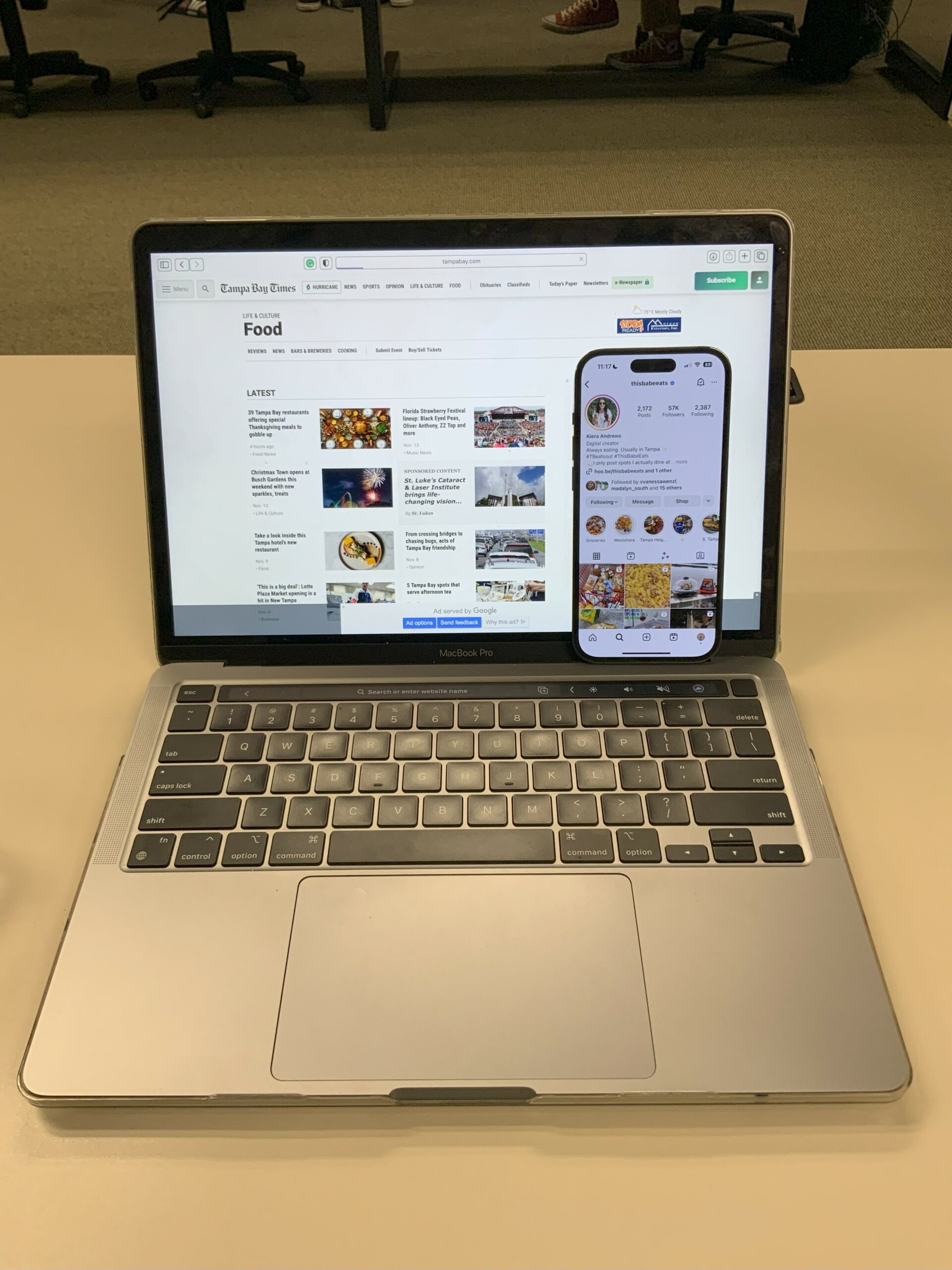Over the last decade, social media influencers and bloggers have created a space for themselves in the food marketing world and food journalism has evolved because of it.
By Kaitlyn Bock Food Beat Reporter
Food influencers are changing the food journalism and marketing industries one Instagram post at a time.
In the early 2000s, news organizations like the Tampa Bay Times, had large sections for food journalism in their newspapers and entire teams of food journalists.
“I would say when I started in 2000, if you were in the Tampa Bay area and you wanted information about food, whether it was new restaurants or trends in cooking or anything like that, you had the St. Pete Times, well now the Tampa Bay Times,” Janet Keeler, former Food Editor for the Tampa Bay Times, said.
Even nine years ago when Helen Freund, the Tampa Bay Times food critic, started in restaurant criticism there still was not a huge market for social media and bloggers in the food marketing industry.
“At the time, there really was no competition if you want to call it competition from bloggers or social media influencers, that just didn’t really exist back then,” Freund said.
Freund’s only other competition was other reporters, food critics, and dining room reporters at other publications.
In the last 10 years, there has been a shift in food marketing and food journalism to more bloggers and influencers on a variety of social media platforms.
“By the time 2015 came along, there were starting to be more bloggers, and definitely the digital scene was really exploding,” Keeler said. “That didn’t exist when I started, there were more people writing online about food.”
In October of 2014, Kiera Andrews, also known as This Babe Eats on Instagram, launched her food-focused Instagram. At that time, there were not many other food blogs or Instagram posts only food content.
“I was like you know what, I’m looking for something fun to do because I did not love my job, I had just graduated from college and I was kind of bored, so I wanted a creative outlet,” Andrews said. “So, I decided I love food, I love going out to eat, I might as well share that.”
After college, Andrews worked for several companies doing a wide range of media strategies and had her food Instagram on the side for fun, but also turned it into a side hustle by running other restaurants’ Instagram account and monetizing her content through branded partnerships.
In 2020, Andrews was able to go full-time with her social media platform because she had developed a solid foundation of about 40,000 followers.
In recent years, the food marketing/ influencing industry has become more saturated with people posting about food to get free food from the restaurants they are promoting. However, that was never Andrews’ intention.
“I did it because I wanted a hobby,” Andrews said. “I still to this day pay for probably 95 percent of what you see on my page.
With the market being over-saturated with bloggers and influencers, many accounts are writing and posting about all of the same things.
“You gotta be original,” Andrews said. “I try to go out there and find some small, locally owned places that not one else is posting about to try to shake it up and keep what I’m putting out there different from everybody else.”
To keep her content original, Andrews finds places to try that are not getting a lot of press. One thing that she does differently than other food influencers is posting strictly photos on Instagram while many post a lot of reels, she likes to keep videos on her TikTok platform.
In a digital age of influencers and bloggers, news food critics and food journalists are competing with each other as well as the influencers to post and write original content.
“We try to hope and trust that our readers understand the difference [between journalism and social media influencers],” Freund said. As newspapers started to report less about food because of budget cuts and financial problems, bloggers and influencers started to fill the gap and be the main source of food content for more people.
“When I started, it was pretty robust, but when I left in 2015 newspapers were starting to, well not starting, were having more financial problems and they were looking for places to cut and that was an area they were cutting,” Keeler said.
Authenticity is a huge part of Andrews’ brand; she will only share content about places that she genuinely supports which has created a following of people that trust her and her opinions about the places she chooses to post.
As a journalist and food critic, Freund uses a formula that she has created for herself when reviewing a restaurant. She will go with other people and order many dishes and bounce opinions off of them, but she will also go back alone to compare the experiences.
It is also more than just the food; she will pay attention to the ambiance and what is happening in the restaurant on top of the presentation and taste of the food.
When Freund moved to the Tampa Bay area a little over four years ago, she noticed the different markets for food marketing through influencers and bloggers who already had an established presence.
Many of the things that food bloggers and influencers share are shown in a positive light, whether it is because they fully support that restaurant and want to share it with their followers like Andrews does on her platforms, or because they are being hosted by the restaurant.
Even with the continuous boom in social media food influencers and food bloggers, there is still a key difference between influencers and journalists.
“In traditional food journalism, you’re mostly trying to dine anonymous or unannounced and you’re not taking free meals,” Freund said. “You’re sharing with your reader the full experience that you had.”
As society continues to become more based around social media and digital content, the two worlds will continue to overlap because of the ever-changing presence of social media in peoples’ everyday lives.
“When you talk about a social media presence, I think there is some competition there because there are people that are following influencers who are getting their information on restaurants and where to go out from them whereas five years ago, that wasn’t the case,” Freund said.
Even though there is a clear difference between influencers and journalists, both will continue to adapt in ways they haven’t previously.

